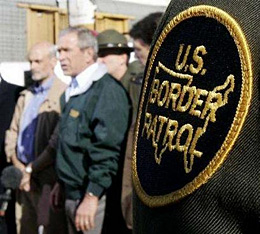 |
 |
 |
 Editorials | Opinions | December 2005 Editorials | Opinions | December 2005  
U.S. Extends - and Withdraws - Hand
 Douglas S. Massey - Miami Herald Douglas S. Massey - Miami Herald


| | U.S. President George W. Bush speaks near the fence at the Mexican border in El Paso, Texas, November 29, 2005. (Reuters/Jim Young) |
It's no secret that the U.S. immigration system is badly broken. It has been broken since 1986 and is getting worse. Rep. Steve King, R-Iowa, has proposed building a fence along the entire border with Mexico. President Bush, speaking last week in Arizona, stated that "illegal immigration's a serious challenge, and our responsibility is clear. We are going to protect the border."

Unfortunately, unilateral attempts to close the border will only worsen the problem. The central problem concerns the relationship between Mexico and the United States.

After Canada, Mexico is our largest trading partner. We share a border of almost 2,000 miles and trade that totals $286 billion a year. The movement of goods and services is accompanied by the movement of people. In 2004 some 175,000 legal immigrants arrived from Mexico, along with 3.8 million visitors for pleasure, 433,000 business visitors, 118,000 temporary workers, 25,000 intra-company transferees, 29,000 students and exchange visitors and 6,200 traders and investors. One million Americans live in Mexico, and 19 million visit there annually. U.S. foreign direct investment in Mexico totals $62 billion annually.

These massive, cross-border flows occur under the auspices of the North American Free Trade Agreement. But at the heart of NAFTA lies a contradiction: Even as the United States promotes free movement of goods, services, capital and information, we somehow seek to prevent the movement of labor. We wish to create a North American economy that integrates all markets except one: that for labor.

To maintain the illusion that we can somehow integrate and remain separate, the United States has militarized its border with a friendly country that poses no conceivable threat to U.S. national security. Even as bi-national trade with Mexico grew eightfold from 1986 to the present, the Border Patrol's enforcement budget increased tenfold. The Border Patrol is now the largest arms-bearing branch of the federal government save the military itself, with an annual budget exceeding $1.4 billion.

But our attempts to stop the flow of Mexican workers through unilateral enforcement have not only failed miserably, they have backfired. Heightened border enforcement has neither deterred would-be immigrants nor reduced the inflow. It has channeled migrants away from traditional crossing points to remote areas where the physical risks are great but the likelihood of getting caught is small. As a result, the number of deaths has risen to around 460 people a year while the probability of apprehension has fallen from a historical average of around 33 percent to around 10 percent.

We're spending more tax dollars to catch fewer migrants and cause more deaths, and once they are deflected from traditional crossing points, Mexicans have moved on to new destinations. Whereas two-thirds of Mexicans who came to the United States during 1985-90 went to California, in the past five years only one-third have done so. Our misplaced border policies have transformed what was a limited regional movement affecting three states into a mass migration to 50 states.

U.S. policies have also pushed Mexican migrants away from seasonal movement toward permanent settlement. Raising the costs and risks of undocumented entry has not deterred would-be migrants, but discouraged them from going home once they're here. Loath to face the hazards of border crossing again, they hunker down for the long term, sending for spouses and children. Rather than remaining a circular flow of temporary male workers, migration has produced a settled population of permanent residents and families, driving up immigration's social and economic costs to American taxpayers.

Instead of attempting to stop the cross-border movement through unilateral police actions, we should bring these immigrants above board, legalize them and manage them in ways that minimize the costs and maximize the benefits for all concerned.

Instead of viewing Mexican migration as a pathological product of rampant poverty and rapid population growth, we should see it for what it is: a natural byproduct of economic development in a relatively wealthy country undergoing a rapid transition to low fertility in close association with the United States.

Mexico has a trillion-dollar economy, with per-capita income approaching $10,000; a 92 percent literacy rate; a total fertility rate of 2.2 children per woman; and population growth of just 1.2 percent per year. Seeking to manage immigration rather than repress it would put policymakers in a better position to protect U.S. workers, lower the costs of immigration to taxpayers and enhance the security of American citizens.

Douglas C. Massey, a professor of sociology and public affairs at Princeton University, is co-author of the book Beyond Smoke and Mirrors: Mexican Immigration in an Age of Economic Integration. | 
 | |
 |



